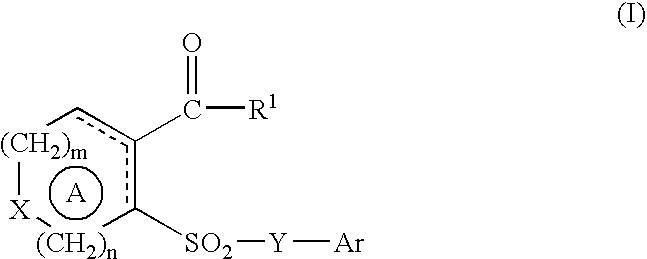Substituted aromatic-ring compounds, process for producing the same, and use
a technology of aromatic rings and substituted compounds, applied in the field of new cycloalkene derivatives, can solve the problems of inconvenient time for organisms, insufficient activity, and excessive production of these cytokines
- Summary
- Abstract
- Description
- Claims
- Application Information
AI Technical Summary
Benefits of technology
Problems solved by technology
Method used
Image
Examples
reference example 1
[0240]To a solution of ethyl 6-[N-(2,4-difluorophenyl)sulfamoyl]-1-cyclohexene-1-carboxylate (1 g, synthesized according to the method disclosed in JP-A-10-056492) and phenylmethanethiol (719 mg) in N,N-dimethylformamide (20 ml) was added dropwise under ice-cooling 1,8-diazabicyclo[5,4,0]-7-undecene (441 mg) and the mixture was stirred at room temperature for 18 h. The reaction mixture was diluted with ethyl acetate (100 ml), washed with water (70 ml×2) and saturated brine (70 ml), and dried over anhydrous sodium sulfate. The solvent was evaporated and the obtained residue was purified by flash silica gel column chromatography (eluent: toluene) to give ethyl 6-(benzylsulfanyl)-1-cyclohexene-1-carboxylate (673 mg) as a colorless oil. 1H-NMR(CDCl3)δ: 1.27 (3H, t, J=7.0 Hz), 1.55–2.36 (6H, m), 3.76 (1H, m), 3.86 (2H, s), 4.19 (2H, q, J=7.0 Hz), 6.95 (1H, t, J=4.0 Hz), 7.22–7.39 (5H, m).
reference example 2
[0241]In the same manner as in Reference Example 1, ethyl 6-[N-(2,4-difluorophenyl)sulfamoyl]-1-cyclohexene-1-carboxylate (1 g) and (4-methoxyphenyl)methanethiol (893 mg) were reacted to give ethyl 6-[(4-methoxybenzyl)-sulfanyl]-1-cyclohexene-1-carboxylate (848 mg) as a colorless oil.
[0242]1H-NMR(CDCl3) δ: 1.28 (3H, t, J=7.0 Hz), 1.57–2.32 (6H, m), 3.74 (1H, m), 3.80 (3H, s), 3.82 (2H, s), 4.20 (2H, q, J=7.0 Hz), 6.84 (2H, d, J=8.4 Hz), 6.94 (1H, t, J=4.0 Hz), 7.29 (2H, d, J=8.4 Hz).
reference example 3
[0243]In the same manner as in Reference Example 1, ethyl 6-[N-(2,4-difluorophenyl)sulfamoyl]-1-cyclohexene-1-carboxylate (455 mg) and (2,4-difluorophenyl)-methanethiol (421 mg) were reacted to give ethyl 6-[(2,4-difluorobenzyl)sulfanyl]-1-cyclohexene-1-carboxylate (185 mg) as a colorless oil.
[0244]1H-NMR (CDCl3) δ:1.26 (3H, t, J=7.0 Hz), 1.60–2.40 (6H, m), 3.78 (1H, m), 3.84 (2H, s), 4.18 (2H, q, J=7.0 Hz), 6.76–6.88 (2H, m), 6.97 (1H, t, J=4.4 Hz), 7.34–7.46 (1H, m).
PUM
| Property | Measurement | Unit |
|---|---|---|
| molar ratio | aaaaa | aaaaa |
| molar ratio | aaaaa | aaaaa |
| molar ratio | aaaaa | aaaaa |
Abstract
Description
Claims
Application Information
 Login to View More
Login to View More - R&D
- Intellectual Property
- Life Sciences
- Materials
- Tech Scout
- Unparalleled Data Quality
- Higher Quality Content
- 60% Fewer Hallucinations
Browse by: Latest US Patents, China's latest patents, Technical Efficacy Thesaurus, Application Domain, Technology Topic, Popular Technical Reports.
© 2025 PatSnap. All rights reserved.Legal|Privacy policy|Modern Slavery Act Transparency Statement|Sitemap|About US| Contact US: help@patsnap.com



